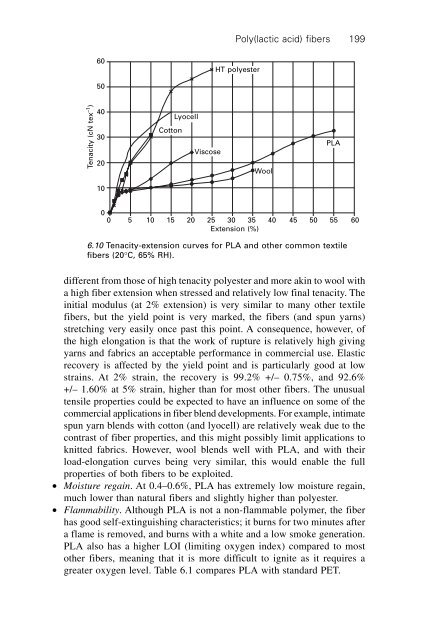Poly(lactic acid) fibers - Jim Lunt LLC
Poly(lactic acid) fibers - Jim Lunt LLC
Poly(lactic acid) fibers - Jim Lunt LLC
- No tags were found...
Create successful ePaper yourself
Turn your PDF publications into a flip-book with our unique Google optimized e-Paper software.
<strong>Poly</strong>(<strong>lactic</strong> <strong>acid</strong>) <strong>fibers</strong> 19960HT polyester50Tenacity (cN tex –1 )403020CottonLyocellViscoseWoolPLA1000 5 10 15 20 25 30 35 40 45 50 55 60Extension (%)6.10 Tenacity-extension curves for PLA and other common textile<strong>fibers</strong> (20∞C, 65% RH).different from those of high tenacity polyester and more akin to wool witha high fiber extension when stressed and relatively low final tenacity. Theinitial modulus (at 2% extension) is very similar to many other textile<strong>fibers</strong>, but the yield point is very marked, the <strong>fibers</strong> (and spun yarns)stretching very easily once past this point. A consequence, however, ofthe high elongation is that the work of rupture is relatively high givingyarns and fabrics an acceptable performance in commercial use. Elasticrecovery is affected by the yield point and is particularly good at lowstrains. At 2% strain, the recovery is 99.2% +/– 0.75%, and 92.6%+/– 1.60% at 5% strain, higher than for most other <strong>fibers</strong>. The unusualtensile properties could be expected to have an influence on some of thecommercial applications in fiber blend developments. For example, intimatespun yarn blends with cotton (and lyocell) are relatively weak due to thecontrast of fiber properties, and this might possibly limit applications toknitted fabrics. However, wool blends well with PLA, and with theirload-elongation curves being very similar, this would enable the fullproperties of both <strong>fibers</strong> to be exploited.∑ Moisture regain. At 0.4–0.6%, PLA has extremely low moisture regain,much lower than natural <strong>fibers</strong> and slightly higher than polyester.∑ Flammability. Although PLA is not a non-flammable polymer, the fiberhas good self-extinguishing characteristics; it burns for two minutes aftera flame is removed, and burns with a white and a low smoke generation.PLA also has a higher LOI (limiting oxygen index) compared to mostother <strong>fibers</strong>, meaning that it is more difficult to ignite as it requires agreater oxygen level. Table 6.1 compares PLA with standard PET.


